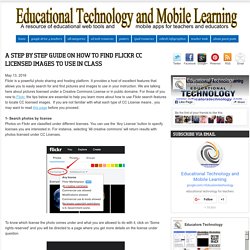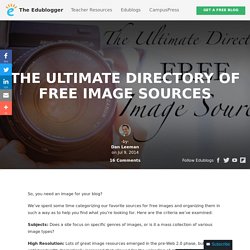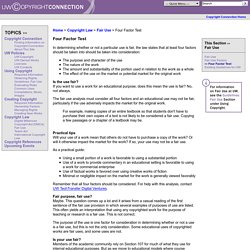

A Step by Step Guide on How to Find Flickr CC Licensed Images to Use in Class. May 13, 2016 Flickr is a powerful photo sharing and hosting platform.

It provides a host of excellent features that allows you to easily search for and find pictures and images to use in your instruction. We are talking here about pictures licensed under a Creative Commons License or in public domaine. For those of you new to Flickr, the tips below are essential to help you learn more about how to use Flickr search features to locate CC licensed images. If you are not familiar with what each type of CC License means , you may want to read this page before you proceed. 1- Search photos by license Photos on Flickr are classified under different licenses.
To know which license the photo comes under and what you are allowed to do with it, click on 'Some rights reserved' and you will be directed to a page where you get more details on the license under question. 3- Search with SafeSearch on This is especially useful when using Flickr with students. Google. How to Use RefME to Create Bibliographies. RefME: bibliography maker. Citing Images overview. Free Clipart. Free Education Clipart. Free Pictures - Wylio, Get pictures. Give credit.
The best music library on the planet! Photos For Class - The quick and safe way to find and cite images for class! Scope & Sequence. Stock Photos, Pictures and Royalty-Free Images. The Ultimate Directory Of Free Image Sources. So, you need an image for your blog?

We’ve spent some time categorizing our favorite sources for free images and organizing them in such a way as to help you find what you’re looking for. Here are the criteria we’ve examined: Subjects: Does a site focus on specific genres of images, or is it a mass collection of various image types? High Resolution: Lots of great image resources emerged in the pre-Web 2.0 phase, but it wasn’t until bandwidth dramatically increased that allowed for the uploading of much higher resolution images suitable for editing and printing. License: The licenses vary extremely from source to source. Safety: Government sites and many specific subject collections are extremely safe for students to use. Search Engines While these websites do not actually contribute image content themselves, they’re able to index images in a way that makes it easier to search for free content. Category Favorite: Bing Images Bing Images Compfight Creative Commons Search Everystockphoto HiveStock.
UW Copyright Connection : Fair Use : Four Factor Test. Four Factor Test In determining whether or not a particular use is fair, the law states that at least four factors should be taken into should be taken into consideration: The purpose and character of the use The nature of the work The amount and substantiality of the portion used in relation to the work as a whole The effect of the use on the market or potential market for the original work Is the use fair?

If you want to use a work for an educational purpose, does this mean the use is fair? No, not always. The fair use analysis must consider all four factors and an educational use may not be fair, particularly if the use adversely impacts the market for the original work. For example, making copies of an entire textbook so that students don't have to purchase their own copies of a text is not likely to be considered a fair use. Practical tips Will your use of a work mean that others do not have to purchase a copy of the work? As a practical guide: Fair purpose, fair use? Teaching Copyright.